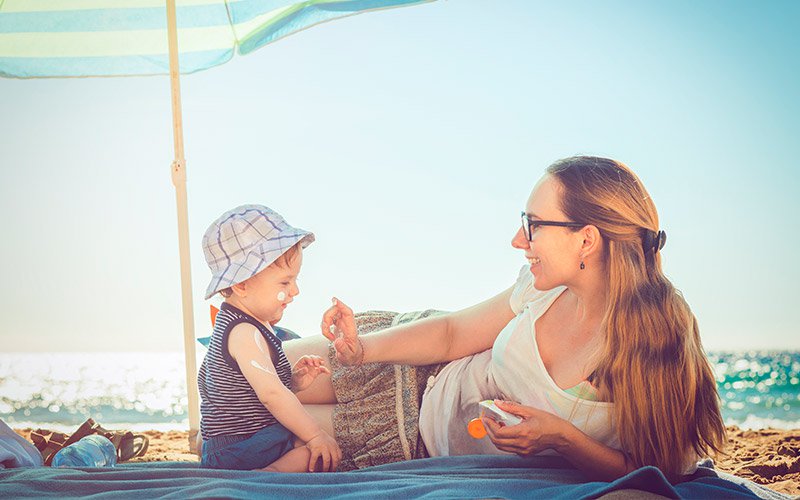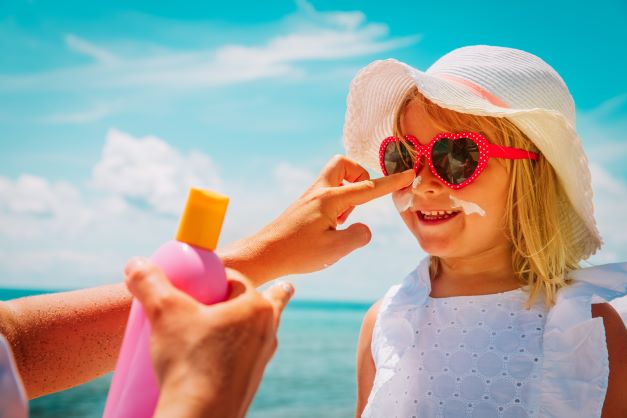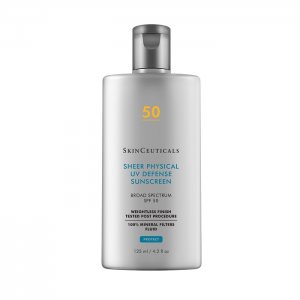Parents know it’s important to keep kids safe and healthy while they’re out enjoying the sun during the spring and summer, and parents also know how important regular sunscreen use is for skin cancer prevention. However, it can sometimes be challenging to talk to children about using sunscreen and taking other steps to stay safe. After all, they want to get outside and have fun. When it comes to helping parents talk to their children about sunscreen, Dr. Gregory Walker of U.S. Dermatology Partners in Waco, Texas, says, “Keep it simple. Be consistent. Make it fun. It’s easier said than done, but those three things are the best advice I can give to parents who are talking to their kids about sunscreen. There are other ways you can make the process a little easier, but if you remember simple, consistent, and fun, you’re halfway there.” In this blog, Dr. Walker will walk through some of the top recommendations for talking to kids about sunscreen.
Why Is Sunscreen So Essential for Infants & Young Children?
According to Dr. Walker, “Even a single blistering sunburn in childhood or adolescence more than doubles the chances of developing melanoma later in life. Skin damage builds up over time, starting with your very first sunburn. The more you burn, the greater your risk of skin cancer, so it’s essential that kids are protected from sun damage.” Clearly, sunscreen application is crucial, even at a young age, to prevent sunburns that can contribute to the risk for skin cancer later in life. In addition to skin cancer, other long-term repercussions of sunburns include accelerated skin aging. People who sunburn or tan more frequently will often see a greater number of fine lines, wrinkles, and age spots as well as skin laxity at younger ages. These potential long-term effects of sun damage are important to keep in mind but don’t forget the many short-term effects of sun damage. Sunburns are painful and can lead to infections and scarring. Numerous sunburns or repeated skin tanning can lead to discoloration or uneven skin tone.
Shop sunscreens online at DermSkincare.com »
Tips for Talking to Kids About Sunscreen
The way we talk to kids about things like sunscreen is really important. They need to understand that using sunscreen matters because skipping sunblock might be dangerous, but we also don’t want to unnecessarily scare them. Making sunscreen part of the daily routine for infants and children at a very young age can make it easier to keep kids committed to applying sunscreen as they grow up. If older children do complain or get impatient with sunscreen application, gently remind them that it’s important to protect their skin.
Additionally, Dr. Walker says, “When talking to kids about serious topics like sun protection, keep it simple, be consistent, and make it fun. When it comes to simple explanations, I encourage parents to remind kids that sunburns will hurt, so they have to be careful. Be consistent. That means applying sunscreen every time they’re going to be playing outside. If you want to be even more consistent, apply sunscreen every day, which is the recommended practice for skin health. Finally, have fun. Keep kids focused on getting to go outside and play. Make it a positive experience. You can even make putting on sunscreen a game. Race with your child to see who can get sunscreen on the fastest. Of course, make sure to touch up areas as needed if they get a little too quick with the application.”
Some additional tips for making the sunscreen application process easier include:
- Get ready early – When kids are ready to go outside to do something fun, it can be hard to keep them calm long enough to get sunscreen on, so don’t put this task off until the last minute. Additionally, sunblock can take 15 minutes or longer to be fully absorbed and effective, so apply the sunscreen earlier when kids are less likely to be distracted or over-excited.
- Practice what you teach – Make sure you’re applying sunscreen with your children. If they hear you saying it’s important but don’t see you putting on sunscreen, they’re less likely to take you seriously.
- Don’t be overly reliant on scare tactics – We don’t want to cause unnecessary levels of anxiety in our kids, so while we may be worried they’ll develop skin cancer, this is not necessarily the best way to convince children – especially younger children. Instead, keep them focused on the potential for immediate concerns like painful sunburns.
What Kinds of Sunscreen Should Be Used for Babies & Kids?

Are There Other Ways to Prevent Sunburn in Infants & Children?
In addition to applying and reapplying sunscreen regularly, keep the following tips in mind to help kids avoid sun damage:
- Protect babies under 6 months from direct sunlight by covering them with an umbrella or stroller canopy.
- Dress children in long-sleeved shirts and full pants made from lightweight materials to limit sun exposure.
- Wear hats to protect the face, neck, and eyes from sun exposure.
- Wear sunglasses to protect eyes from UV exposure.
- Stay indoors or limit direct sun exposure between 10 am and 4 pm when UV rays are stronger.
- Periodically seek shade under umbrellas, indoors, or even under trees, especially if you and your child will be outdoors for an extended time.
- Remember that when near water, such as at the pool, lake, or beach, sun rays reflect off the water and sunburns can occur even when sitting in the shade, which makes applying sunscreen even more important in these settings.
What Should Parents Do When Kids Get Sunburned?
If your child does get a sunburn, they may be very uncomfortable. As a parent, it can be difficult to help kids stay calm until they feel better.
When sunburns happen, parents should take the following steps to address the symptoms:
- For babies less than a year old, call your child’s doctor immediately after sunburn occurs and follow care instructions.
- For toddlers and older children, you would only need to consult a doctor if the sunburn is severe enough to cause blistering, fever, or pain that keeps the child from sleeping.
- To soothe mild sunburns, apply cold compresses, aloe vera gel, and other topical ointments. Check with your child’s doctor to make sure any medicated creams, gels, and lotions are safe.
- Keep children out of the sun until the sunburn heals.
- Provide children with pain relievers like acetaminophen or ibuprofen in liquid, chewable, or pill form as is age-appropriate.
Need to Work with a Dermatologist?
If your child has a severe sunburn or other skin health concerns, the U.S. Dermatology Partners team is here to help. We welcome adults and children to visit our offices. You can get started scheduling an appointment for yourself or your child by completing our online scheduling request form. We look forward to hearing from you soon.
Find a location near me
or



